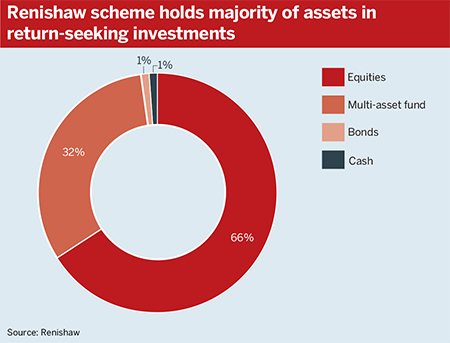British engineering company Renishaw has been in discussions with the Pensions Regulator after the watchdog questioned its recovery plan, potentially leading to a £45m cash contribution to the scheme if the current recovery plan is terminated.
The company agreed a new recovery plan with the trustees in June 2016 for the 2015 actuarial valuation, based on funding to self-sufficiency over the period to 2031.
But Renishaw’s 2018 annual report shows that “discussions with the Pension Regulator are ongoing in relation to the timing of the scheme funding”.
If a company is in a strong position, clearly cash is king
Richard Farr, Lincoln Pensions
Renishaw maintains a pension scheme escrow account, with a balance of around £10.4m, as part of the security given for its £151.8m UK defined benefit scheme.
The scheme also has a charge over some UK properties, valued during 2015 and 2016 at £62.3m, as financial security for this recovery plan period. The company has also made cash contributions to the scheme in line with the plan.
Allen Roberts, group finance director, wrote in the report: “The company, trustees and their respective advisors concluded that the 2016 agreement was in the best interest of the scheme members.”
The plan was submitted to the regulator in July 2016. The watchdog’s October 2017 response “questioned whether the 2015 recovery plan provides greater security than the 2012 recovery plan, which funded to technical provisions only but required an earlier cash injection”, Roberts wrote.
Both the company and the trustees have held discussions with the regulator to detail how each party satisfied itself that the 2016 recovery plan was preferred. Roberts said Renishaw and the trustees continue to engage with the watchdog.
Cash contribution looms
In the meantime, they are complying with the terms of the 2016 agreement. If the 2016 agreement terminates, the trustees and the company may be required to revert to the 2012 recovery plan, according to the report.
“In this event the company would be required to make a contribution to the scheme of approximately £45m, adjusted for company deficit repair contributions and the potential investment return had the contribution been invested in October 2016,” Roberts wrote.
He added that they would also have to agree a new recovery plan with the trustees, and that the next triennial valuation will be undertaken on September 30 2018.
The company could not be reached for further comment.
Covenant strength is key to decision-making
Richard Farr, managing director at covenant specialists Lincoln Pensions, said the situation set out in Renishaw’s accounts is unusual.
“If you’ve already agreed to get a lot of cash in, and you swap for security, you have to be very careful that [giving up] the cash is actually worth it,” he said.
“It’s not surprising that CFOs, in the current environment, Brexit looming… want some preserved cash, and it’s logical to suggest... more security to minimise any cash call,” Farr said.
“The question is whether or not the cash call could actually stress the company,” he noted, adding that the regulator would be unlikely to push for cash if it would put strain on the company.
“If a company is in a strong position, clearly cash is king,” Farr said. There may, however, be a business case for the scheme not having cash, such as the need to invest in growth.
Farr added: “It’s a conversation between the two parties about the best use of money. At the same time, if you don’t believe the company’s going to spend it wisely, grab the cash”.
Contingent assets provide flexibility for employers
A large amount of the pension scheme’s assets are in return-seeking assets.
Martin Hunter, principal at XPS Pensions Group, said the Renishaw scheme’s investment strategy is “probably more high risk than the average”.

Trustees usually take that kind of approach if they are satisfied that the company is strong and “able to stand behind the pension liabilities and then make up any deficit if the investment returns don’t turn out to be good”, he said.
A company might be reluctant to make a large cash contribution now if it expects its investment strategy to be successful in the long term. But contingent assets would still give the trustees comfort that they can take on that level of risk, Hunter said.
Contingent assets allow the company “to have some flexibility around the amount they pay into the scheme, as well as the level of risk that the scheme takes through its investment strategy”, he said.
When agreeing a new recovery plan, communication between the trustees and the company is crucial.
Rob Dales, director at JLT Employee Benefits, advised schemes to “engage with the employer early in the process to… seek to understand where the employer is coming from”.
This means both parties will have realistic expectations, and will be able to come to an agreement.














